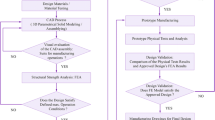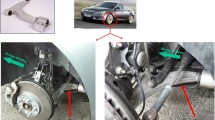Abstract
The development and validation of an original aluminum bicycle crank arm design is presented with an emphasis on design for manufacturing and cost-efficiency via Industry 4.0 principles. The facets of Industry 4.0 that were utilized in this work include the development of a predictive technical cost model, real-time data acquisition from the processing equipment, as well as intentional design for manufacturability. Two crank arm designs were manufactured and tested in a custom mechanical testing jig. The adjustable apparatus was used to test the crank arms in multiple loading cases realistic to those experienced during a typical service life, in addition to testing the load case defined by the International Organization for Standardization (ISO). Metrology was then conducted of all crank arms to assess the part deformation after mechanical testing. A predictive technical cost model was also developed of the entire design and manufacturing process that allows for factors such as cycle time, energy consumption, and production efficiency to be utilized to maximize sustainability in the manufacturing process. The crank arms presented met the ISO specifications for crank arm safety, and showed comparable performance to a commercial aluminum crank arm. This successful product development cycle can be utilized in future research to adopt different material systems into the process for increased sustainability or performance or both, as well as to serve as a demonstrator of the implementation of next-generation manufacturing principles.









Similar content being viewed by others
References
Wang L, Törngren M, Onori M (2015) Current status and advancement of cyber-physical systems in manufacturing. J Manuf Syst 37:517–527. https://doi.org/10.1016/j.jmsy.2015.04.008
Ghobakhloo M (2020) Industry 4.0, digitalization, and opportunities for sustainability. J Clean Prod. https://doi.org/10.1016/j.jclepro.2019.119869
Dalenogare L, Benitez G, Ayala N (2018) The expected contribution of Industry 4.0 technologies for industrial performance. Int J Prod Econ 204:383–394. https://doi.org/10.1016/j.ijpe.2018.08.019
Culot G, Nassimbeni G, Orzes G, Sartor M (2020) Behind the definition of Industry 4.0: analysis and open questions. Int J Prod Econ 226:107617
Gonzalez H, Hull M (1989) Multivariable optimization of cycling biomechanics. J Biomech. https://doi.org/10.1016/0021-9290(89)90217-0
Ismail A, Na G, Koo B (2020) Topology and response surface optimization of a bicycle crank arm with multiple load cases. Appl Sci. https://doi.org/10.3390/app10062201
Balbinot A, Milani C, Nascimento JSB (2014) A new crank arm-based load cell for the 3D analysis of the force applied by a cyclist. Sensors. https://doi.org/10.3390/s141222921
Gutiérrez-Moizant R, Ramírez-Berasategui M, Calvo J, Álvarez Caldas C (2020) Validation and improvement of a bicycle crank arm based in numerical simulation and uncertainty quantification. Sensors. https://doi.org/10.3390/s20071814
Oosterhuis H (1989) Cycling, modernity and national culture. Soc Hist 41:233–248. https://doi.org/10.1080/03071022.2016.1180897
Trek (2021) Sustainability report and corporate commitment. https://www.trekbikes.com/us/en_US/sustainability/. Accessed 22 Mar 2022
ISO (2014) Cycles-safety requirements for bicycles—part 3: common test methods. International Organization for Standardization, ISO 4210-3:2014. https://www.iso.org/standard/59910.html Accessed 7 August 2021
ISO (2014) Cycles-safety requirements for bicycles—part 8: pedal and drive system test methods. International Organization for Standardization 4210-8:2014. https://www.iso.org/standard/59915.html Accessed 7 August 2021
EU (2005) Racing bicycles—safety requirements and test methods. European Standard 14781:2005
Chamberlain M, Miller J, Heflin D, Dowd T, Rhim J, Akturk I, Coffing J, Mansson JA (2022) Cycling and sustainability: development of a recycled carbon fiber (rcf) crankset demonstrator. In: International sports engineering conference (ISEA) conference Proceedings
McCullough R, Jordon J, Allison P, Rushing T, Garcia L (2019) Fatigue crack nucleation and small crack growth in an extruded 6061 aluminum alloy. Int J Fatigue. https://doi.org/10.1016/j.ijfatigue.2018.09.023
Itoh T, Nakata T, Sakane M, Ohnami M (1999) Nonproportional low cycle fatigue of 6061 aluminum alloy under 14 strain paths. Eur Struct Integr Soc. https://doi.org/10.1016/S1566-1369(99)80006-5
Glebes R, Dustin J, Mansson JA (2019) Technical cost modeling methodology for novel manufacturing. SAMPE 2019-Charlotte, NC, May 2019
Wakeman MD, Månson JA (2005) Cost analysis. In: Design and manufacture of textile composites. Woodhead Publishing. 364–404. https://doi.org/10.1533/9781845690823.364
Turner TA, Harper LT, Warrior NA, Rudd CD (2008) Low-cost carbon-fibre-based automotive body panel systems: a performance and manufacturing cost comparison. Proc Inst Mech Eng Part D J Automob Eng 222(1):53–63. https://doi.org/10.1243/09544070JAUTO406
Baumers M, Holweg M (2016) Cost impact of the risk of build failure in laser sintering. In: 2016 international solid freeform fabrication symposium
Baumers M, Holweg M (2019) On the economics of additive manufacturing: experimental findings. J Oper Manag 65(8):794–809. https://doi.org/10.1002/joom.1053
Gutowski T, Hoult D, Dillon G, Neoh ET, Muter S, Kim E, Tse M (1994) Development of a theoretical cost model for advanced composite fabrication. Compos Manuf 5(4):231–239. https://doi.org/10.1016/0956-7143(94)90138-4
Bader MG (2002) Selection of composite materials and manufacturing routes for cost-effective performance. Compos Part A Appl Sci Manuf 33(7):913–934. https://doi.org/10.1016/S1359-835X(02)00044-1
LeBlanc DJ (1976) Advanced composite cost estimating manual. Northrop Corporation, Aircraft Division, Denver
Ruffo M, Tuck C, Hague R (2006) Cost estimation for rapid manufacturing–laser sintering production for low to medium volumes. Proc Inst Mech Eng Part B J Eng Manuf 220(9):1417–1427. https://doi.org/10.1243/09544054JEM517
Ilcewicz L, Ashforth C (2017) Scaling crucial to integrated product development of composite airframe structures. Compr Compos Mater II:26–90. https://doi.org/10.1016/B978-0-12-803581-8.10314-5
Glebes RJ, Dustin JS, Mansson JAE (2019) Technical cost modeling methodology for novel manufacturing. SAMPE 2019—Charlotte, NC
Acknowledgements
The authors wish to express gratitude towards the Ray Ewry Sports Engineering Center (RESEC) at Purdue University, as well as the Indiana Next Generation Manufacturing Competitiveness Center (IN-MaC) for providing the financial support for this project.
Author information
Authors and Affiliations
Corresponding author
Ethics declarations
Funding
Financial support for this study was provided by the Ray Ewry Sports Engineering Center (RESEC) at Purdue University, as well as the Indiana Next Generation Manufacturing Competitiveness Center (IN-MaC).
Conflict of interest
Professor Jan-Anders Mansson served as a guest editor for the Topical Collection on The Engineering of Sport 14 and he was not involved in the blind peer review process of this work.
Additional information
Publisher's Note
Springer Nature remains neutral with regard to jurisdictional claims in published maps and institutional affiliations.
This article is a part of a Topical Collection in Sports Engineering on The Engineering of Sport 14 Conference held at Purdue University USA, edited by Dr Hugo Espinosa, Steven Shade, Dr Kim Blair and Professor Jan-Anders Månsson.
Rights and permissions
Springer Nature or its licensor (e.g. a society or other partner) holds exclusive rights to this article under a publishing agreement with the author(s) or other rightsholder(s); author self-archiving of the accepted manuscript version of this article is solely governed by the terms of such publishing agreement and applicable law.
About this article
Cite this article
Chamberlain, M., Miller, J., Dowd, T. et al. Development of a bicycle crank arm demonstrator via Industry 4.0 principles for sustainable and cost-effective manufacturing. Sports Eng 26, 2 (2023). https://doi.org/10.1007/s12283-022-00394-1
Accepted:
Published:
DOI: https://doi.org/10.1007/s12283-022-00394-1




